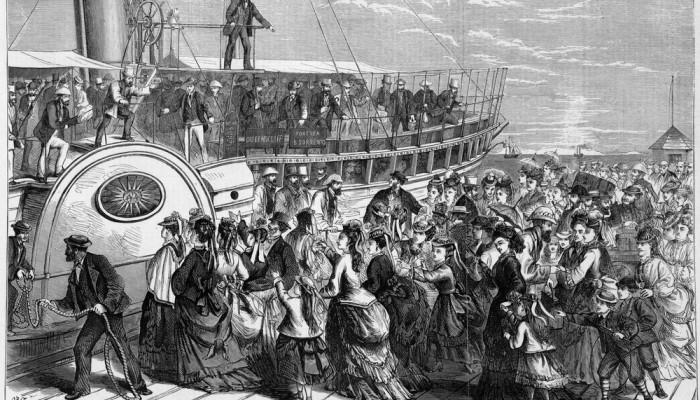How inclusive is Australian history?
Last year saw the publication of at least 74 books that featured the memoirs, or were based on the recollections of, people from non-English-speaking backgrounds who had migrated to Australia.
The National Library of Australia holds more than a thousand such books. The earliest were published more than 50 years ago. They include, for example, Impudent Foreigner, a 1963 memoir by Hungarian-born Anne Varsanyi, who had migrated to Australia as a displaced person after World War II and wrote under the pen name Cecile Kunrathy.
Her book “is basically an entertaining and absorbing story”, the publisher’s blurb informed prospective readers; but its author also “gives us an object lesson in adaptation that could help all migrants”. The book was favourably reviewed, not least because it was seen as a complimentary account of Australia and Australians. “Cecile Kunrathy persuades us that we are not such a bad lot after all”, the Daily Telegraph observed, “and in the process reveals herself to be a gay, charming person”.
Eminent Australian poet Kenneth Slessor, who had reviewed the manuscript for the Commonwealth Literary Fund, had liked that it “is a kind of success-story and therefore not only a counterblast to the complaints of disgruntled migrants but excellent propaganda for Australian migration as a whole”. But he suggested that the first part of the book, which dealt with Varsanyi’s pre-migration experiences in Europe, be pruned, because her account “could be duplicated, no doubt, by [the accounts of] many thousands of others who suffered during the war”.
Other European migrants writing their memoirs in the 1960s, 1970s and 1980s omitted descriptions of their lives prior to arrival in Australia, perhaps sensing that there was little interest among Australian readers in such accounts. Canberra resident Magda Bozic, for example, whose memoir Gather Your Dreams was published in 1984, did not even reveal in which country she was born. Jewish survivors were the exception to the rule. Some of them wrote exclusively about their experience of the Holocaust.
Hardly any of the migrants writing in recent years gloss over their pre-migration past. In fact, many authors focus on experiences they made before they migrated, and portray in detail places and cultures that are foreign to their audience. And when writing about Australia, many are more critical of the welcome they received than Varsanyi/Kunrathy was in 1963.
It seems unlikely that a funding body would now advise a writer to privilege the Australian part of her life story. Australian readers want to know what it was like to grow up in Afghanistan (and have the opportunity to learn about it by reading The Rugmaker of Mazar-e-Sharif, which was first published in 2008). They read Isaac Bacirongo’s recent memoir because they are interested in the life of a pygmy in the Democratic Republic of Congo. And the many authors who write about surviving the Holocaust can also count on a captive audience.
The interest in the life stories and cultural baggage of migrants is testament to Australians’ embrace of multiculturalism. But what exactly does this embrace entail?
If I applied for Australian citizenship, I would be advised to read the booklet Australian Citizenship: Our Common Bond, which was published by the immigration department in 2014. Studying it would help me to pass the citizenship test. The booklet’s non-testable section “has important information that will help you to understand the history and culture of Australia”. This includes, for example, a section about Australia’s involvement in World War I. “When you are offered a poppy to wear on 11 November,” the booklet advises, “you will know that it is to remember our fallen servicemen and women.”
The booklet is, of course, silent on Isaac Bacirongo’s history, on the war in Afghanistan, and on the Holocaust. Of course – because Australian history is usually considered to be the history of Australia as a territorially bounded nation state.
But why should that be so self-evident? Why couldn’t Australian history also be the cumulative history of all those living here – irrespective of whether they entered the country as migrants or were born here? And if it could, then wouldn’t that history necessarily include Australian residents’ pre-migration experiences?
The majority of the memoirs written by migrants are self-published. Many are poorly written. Most are released in small print-runs, and often find their way only into a handful of public libraries. I would like to suggest, however, that the lives told in these books are part of Australian history, and an important complement to the history told in the immigration department’s booklet.
That’s also true for the parts of migrants’ memoirs that are concerned with life in Australia. Australia’s immigration history is not only about Arthur Calwell, the White Australia policy and the Snowy Mountains Scheme, but also about the migration experiences of people like Anne Varsanyi, Magda Bozic and Isaac Bacirongo.
It is also about the experience of Najaf Mazari, co-author of The Rugmaker of Mazar-e-Sharif, who arrived in Australia in 2001 by boat, only to be locked up in the infamous Woomera immigration detention centre. Maybe an Australian history capable of accommodating the story of Mazari’s life – in Afghanistan and in Australia – could be less easily abused as the ideological foundation of a nation state whose people are fearful of those who come across the seas.
This article was orginally published here.
